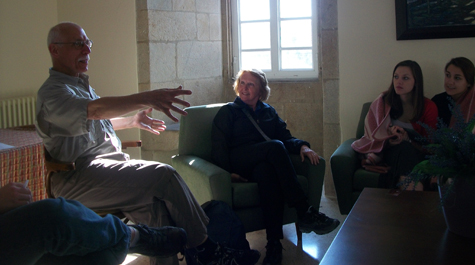Pilgrims' progress: symposium to explore evolution of the pilgrimage
Our understanding of what constitutes a pilgrimage is evolving rapidly, and the 2013 Symposium on Pilgrimage Studies being held Oct. 4-6 at William & Mary is reflective of that evolution.
“We've diversified,” said George Greenia, professor of Hispanic studies and founder of the Institute for Pilgrimage Studies. “The most striking difference in the second year is how many non-Catholic approaches to pilgrimage there are.”
Many approaches to pilgrimage will be represented this weekend at seminars staged at various sites around campus (see schedule for full details). Registration is available on site.
“We've got people coming from a variety of religious traditions, especially protestant traditions you might not expect,” Greenia said. “Baptists are coming from Louisville, Ky., to talk about how can you reconcile or reintegrate pilgrimage in the Baptist tradition. Because of (pilgrimage’s historic) association with Catholicism, they haven’t been as amenable to processions and relics and visiting tombs of saints. They find it not just profane, but misplaced piety.”
Among other religions that stage pilgrimages are Mormons, who replicate their trek from upstate New York to the far west in 19th-century period costumes, over any terrain, in order to create a sense of ownership of their history.
“They literally call it their 'exodus event,'” said Greenia.
Included among the many subjects to be discussed over the weekend include “Pilgrimage in the Celtic world,” “Locating the significance of pilgrimage,” “Pilgrimage as a road to finding self,” “The quest for home: Pilgrimage as metaphor and practice,” “Reading the world in the 14th century,” “Past and present along the Camino de Santiago as reflected in guidebooks,” “A personal reflection on a pilgrimage,” “Remembering a Roman conqueror’s pilgrimage through Greece,” “Artistic and literary responses to the pilgrimage” and “Marathons and half-marathons as contemporary secular pilgrimages.”
More than 35 presenters are expected over the weekend, many from William & Mary, which offers a study-abroad program on pilgrimage studies in Santiago de Compostela, Spain each summer.
However, Greenia says there are also presenters flying in from as far away as Oregon.
Pilgrimage for many traditions is now becoming one of the great metaphors for spiritual engagement and development, he added.
The educational value of a pilgrimage is widespread and varied.
King’s University in Ontario uses it as part of its sociology program. The University of Michigan uses the Camino de Santiago as an architectural/historical tour because one can see pre-Romanesque, Romanesque, Gothic, Renaissance, Baroque, Rococo and modern buildings along the entire trail.
Greenia says that officers in the German army are required to visit concentration camps in Eastern Europe.
“It is part of their military training and formation,” he said. “Their attitude is, ‘we have to know, visibly, what we participated in during the war.’”
American pilgrimages that have evolved include visiting Ground Zero in New York, the Vietnam Memorial in Washington, D.C., or touring Gettysburg and other Civil War battlefields.
“These days, Americans are treating these secular pilgrimages as a trans-generational experience, combining what a pilgrimage is with what our history is,” Greenia said. “People are recovering sections of the Trail of Tears here in the South that anyone can walk to feel what others felt when they were forced into exile. The Underground Railroad is important so that young blacks can feel what it was like for their ancestors to make that journey to freedom.”
Despite the evolution of the pilgrimage, traditional centuries-old treks still remain popular today, including the Camino de Santiago pilgrimage which ends in Santiago de Compostela.
That city suffered a devastating blow in July when a train derailed, killing 80 people and injuring more than 160, including many pilgrims. The accident occurred on the eve of a religious festival that draws tens of thousands of pilgrims from across the globe to the city. A student from Christopher Newport University who was on the pilgrimage lost his mother in the derailment; his father and sister were also injured.
In an effort to honor those who were killed or injured in the tragedy, the William & Mary symposium organizers will make a quiet reflection room available during the event. Participants are also invited to place a stone on a cairn of remembrance and sign a memorial scroll that will be sent to Pilgrims Office in Santiago.
Students, faculty, staff and community members who have never experienced a pilgrimage have the opportunity to try one out immediately following the symposium with a locally-organized Pilgrims Walk.
The walk, which begins at 12:30 at the Days Inn Downtown on Richmond Road, offers students interested in applying to William & Mary’s summer program in Spain a chance to sample the Camino de Santiago trek and meet pilgrims who have walked thousands of miles across the world, said Greenia.
To learn more about the symposium, visit: http://www.wm.edu/sites/pilgrimage/annualsymposium/index.php.
 Skip to main content
Skip to main content



